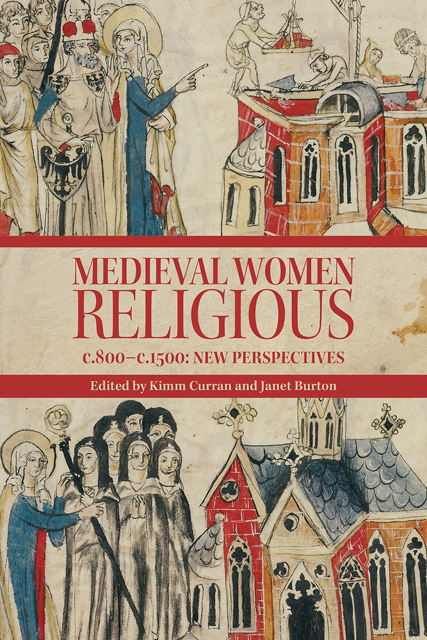Book contents
- Frontmatter
- Contents
- Illustrations
- Contributors
- Preface
- Abbreviations
- Introduction
- 1 Reform, Change, and Renewal: Women Religious in the Central Middle Ages, 800–1050
- 2 New Movements of the Twelfth Century: Diversity, Belonging, and Order(s)
- 3 Change and Renewal: Mendicants and Tertiaries in Later Medieval Europe
- 4 On the Fringes: Anchorites
- 5 ‘Quasi-religious’: Vowesses
- 6 Authority and Agency: Women as Heads of Religious Houses
- 7 Women Religious, Secular Households: The Outside World and Crossing Boundaries in the Later Middle Ages
- 8 Literacies, Learning, and Communal Reform: The Case of Alijt Bake
- 9 Family and Friends: Gift-giving, Books, and Book Inscriptions in Women’s Religious Communities
- 10 Communities of Medieval Religious Women and Their Landscapes
- 11 Materiality and Archaeology of Women Religious
- 12 Between Collective Memory and Individual Remembrance in Women’s Religious Communities
- Select Bibliography
- Index
- Miscellaneous Endmatter
8 - Literacies, Learning, and Communal Reform: The Case of Alijt Bake
Published online by Cambridge University Press: 08 June 2023
- Frontmatter
- Contents
- Illustrations
- Contributors
- Preface
- Abbreviations
- Introduction
- 1 Reform, Change, and Renewal: Women Religious in the Central Middle Ages, 800–1050
- 2 New Movements of the Twelfth Century: Diversity, Belonging, and Order(s)
- 3 Change and Renewal: Mendicants and Tertiaries in Later Medieval Europe
- 4 On the Fringes: Anchorites
- 5 ‘Quasi-religious’: Vowesses
- 6 Authority and Agency: Women as Heads of Religious Houses
- 7 Women Religious, Secular Households: The Outside World and Crossing Boundaries in the Later Middle Ages
- 8 Literacies, Learning, and Communal Reform: The Case of Alijt Bake
- 9 Family and Friends: Gift-giving, Books, and Book Inscriptions in Women’s Religious Communities
- 10 Communities of Medieval Religious Women and Their Landscapes
- 11 Materiality and Archaeology of Women Religious
- 12 Between Collective Memory and Individual Remembrance in Women’s Religious Communities
- Select Bibliography
- Index
- Miscellaneous Endmatter
Summary
With a few exceptions, medieval religious women have for a long time been perceived as unlearned. In recent decades, however, scholars such as Linda Olsson have argued that ‘the complications surrounding past literacies highlight […] the inadequate nature of our established terminology and paradigms’. In other words: we need to think about women's literacies and learning in a different way, for instance by defining different levels of literacy. As the editors of the three volumes on Nuns’ Literacies in Medieval Europe stated, it is important to use the plural ‘literacies’ instead of the singular ‘literacy’ to describe the engagement of religious women in medieval literate culture. The plural ‘literacies’ implies a range of variable literacy levels between different women religious and religious communities.
Women's literacies ranged from practical or pragmatic literacy – the ability to read and/or write simple and everyday sentences – to the understanding of and/or ability to copy or compose more complex texts. Even if they could not read or write (well), medieval women could also be literate in the broader sense of the word by hearing texts that were read out to them: oral literacy. Literacy in the vernacular often differed from Latin literacy. Monica Hedlund stated that considering that Latin was used every day in the convent, most sisters must have learned (at least some) Latin, even though they were perhaps not full participants in Latin intellectual culture. We should, therefore, be aware of the ‘intellectualis-ation of Latin’ in our established terminologies. This chapter discusses how late medieval northern European women religious engaged in literate culture, both in the vernacular and in Latin. A case study focuses on one woman in particular: the rebellious Dutch religious woman, Alijt Bake.
Medieval Women's Literacies and Variations
Women's literacies varied across geographical regions. In Vadstena Abbey in Sweden, for instance, schooling seems to have been going on in the community in the fifteenth century. The Dutch house of Diepenveen near Deventer also had a convent school that was attended by postulants, novices, and initially possibly also by professed sisters who did not yet possess the required skills.
- Type
- Chapter
- Information
- Medieval Women Religious, c.800-c.1500New Perspectives, pp. 137 - 151Publisher: Boydell & BrewerPrint publication year: 2023



